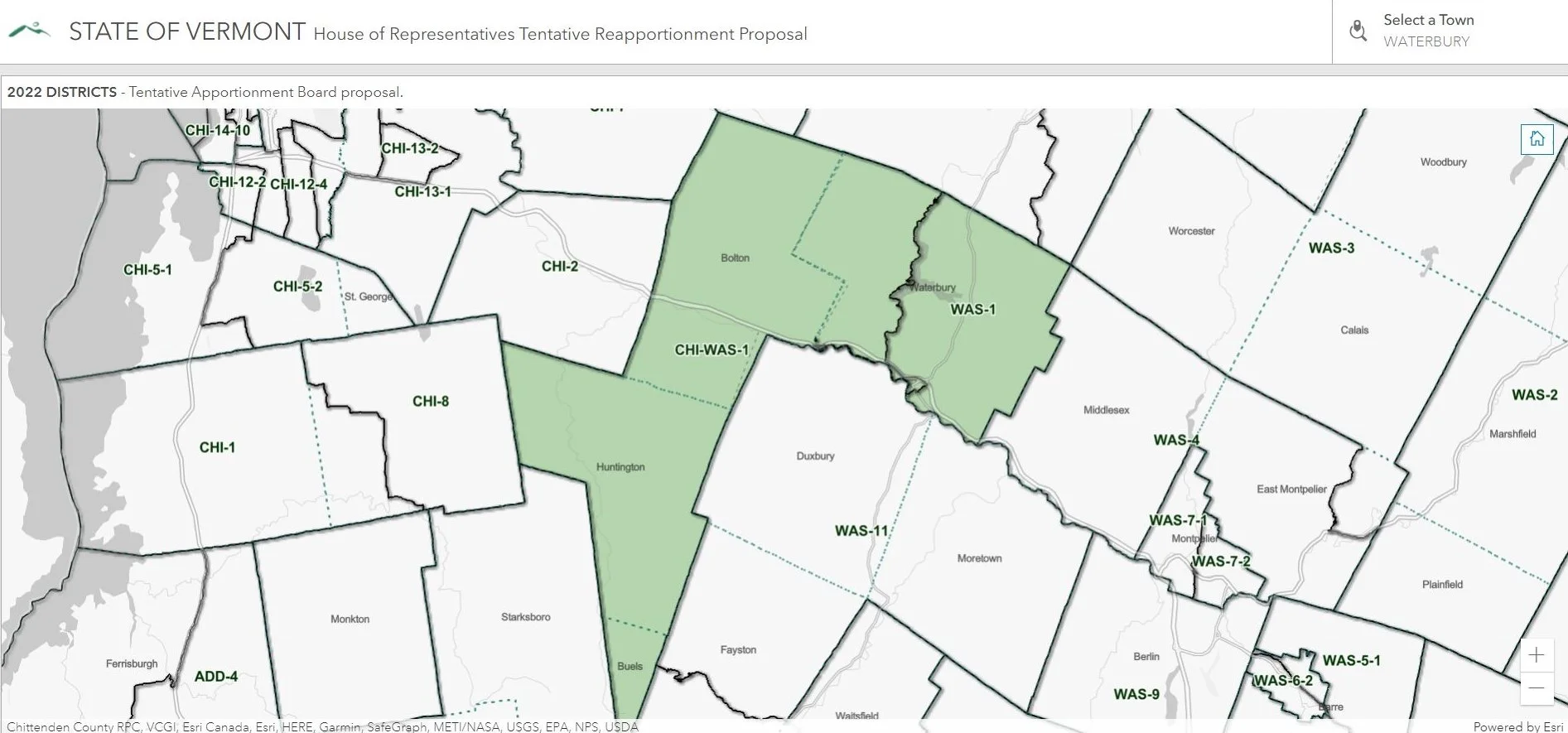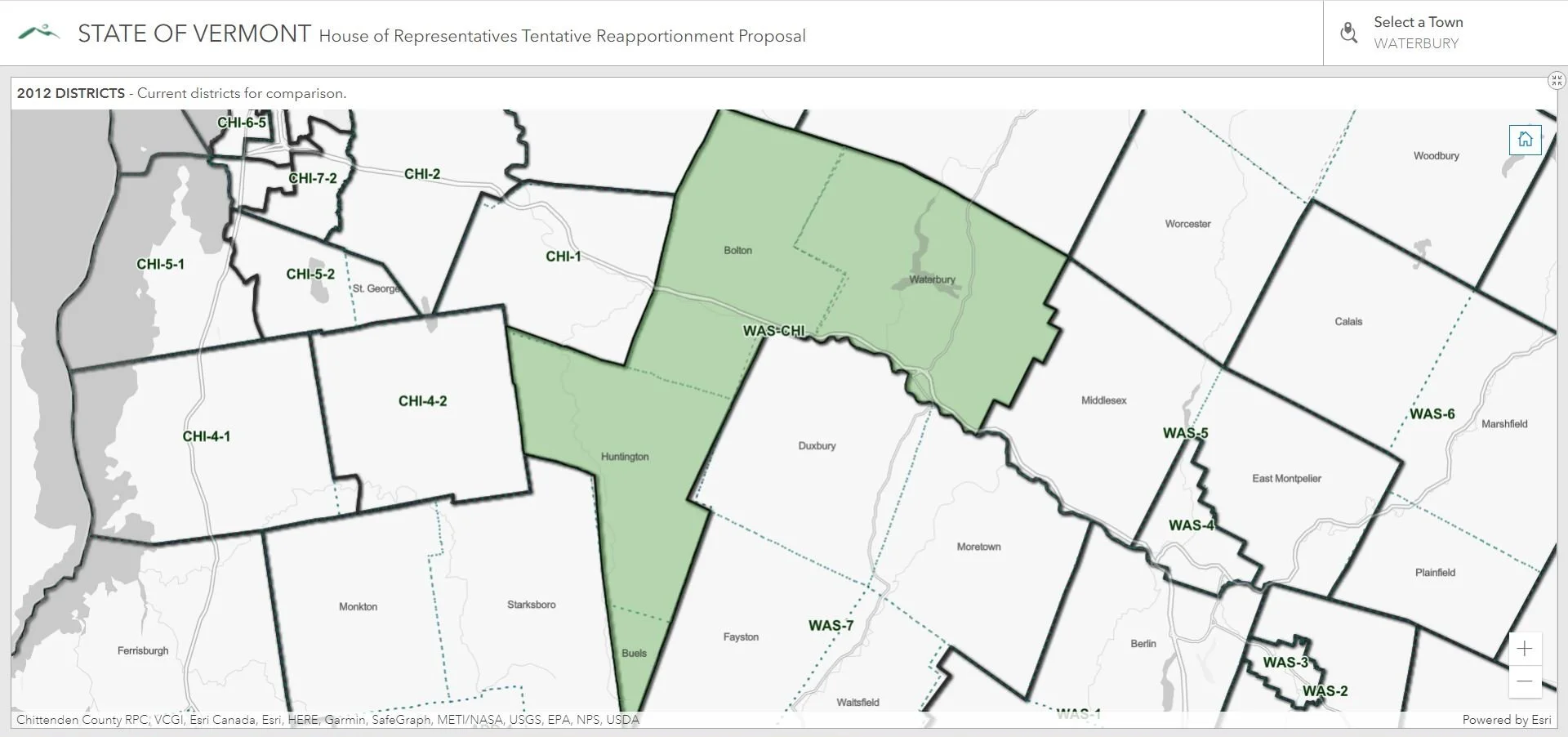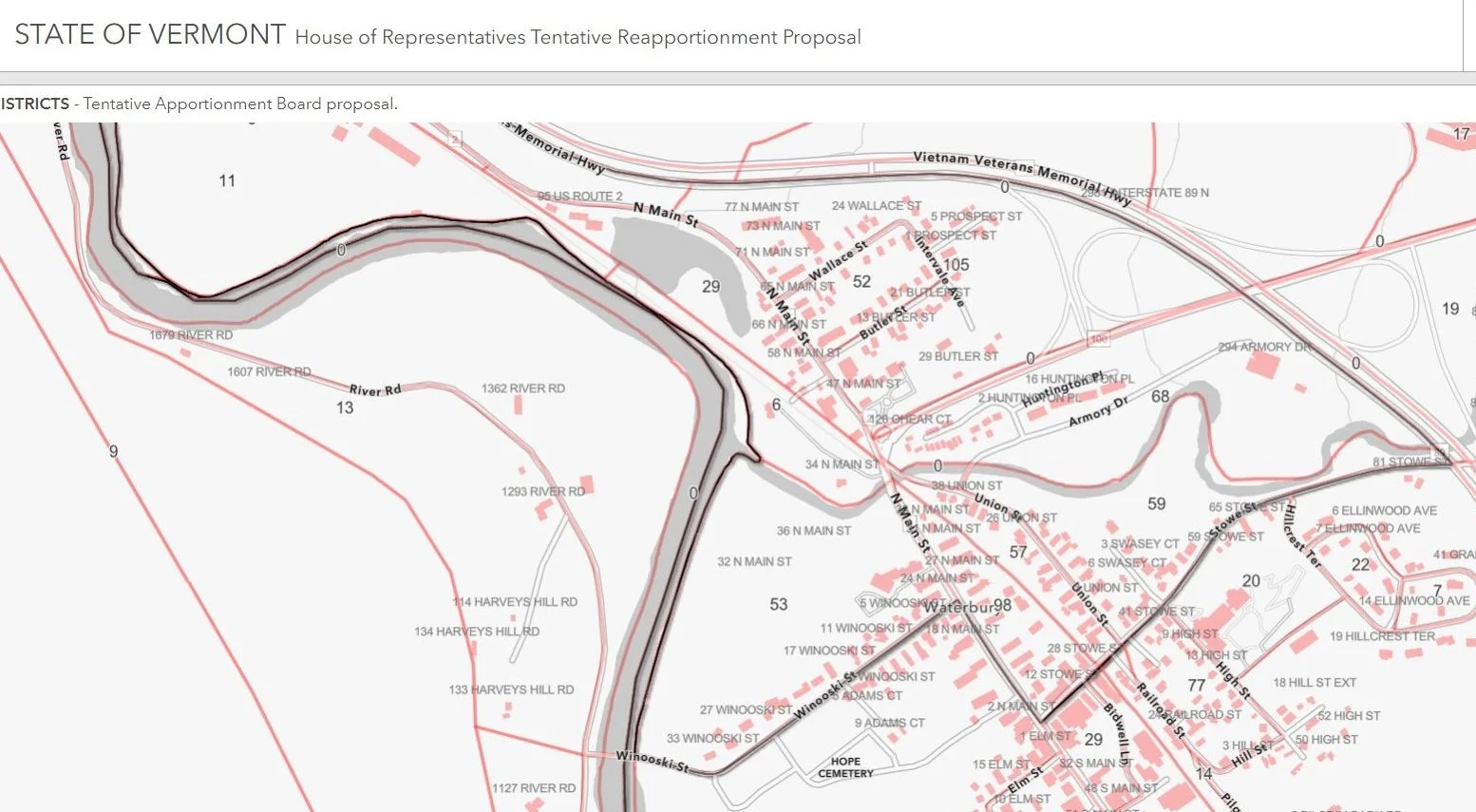Waterbury officials reject House redistricting proposal
Nov. 6, 2021 | By Lisa ScagliottiEditor’s note: This story was updated following the Nov. 4 Board of Civil Authority meeting.
The proposal to shift to one-member House districts in 2022 would split Waterbury into two districts. Washington 1 would be most of the town; Chittenden-Washington 1 would include about 750 Waterbury residents who live west of Little River and along the Rt. 2 and North Main Street corridor south of Interstate 89. Source: Legislative Apportionment Board map
The current two-member Washington-Chittenden House district includes all of Waterbury along with Bolton, Huntington and Buel's Gore. Source: State of Vermont Legislative Apportionment Board map
Waterbury elections officials this week voted unanimously to reject a proposal from the state committee working to redraw legislative districts based on new population data from the 2020 U.S. Census.
The Legislative Apportionment Board is working on revisions to House and Senate legislative districts before the new session begins. The board has circulated a proposal to Boards of Civil Authority around the state seeking feedback by Nov. 15. The proposal calls for 150 single-member representative districts for the House. Currently, representatives are divided into a mix of one- and two-member districts.
That would be a significant change for Waterbury which currently lies entirely in the Washington-Chittenden district along with Huntington, Bolton and Buel’s Gore and has two seats in the House held by Waterbury Democrats Tom Stevens and Theresa Wood. Waterbury lies in Washington County; the other communities are in Chittenden County.
The apportionment board suggests a new district, Washington 1, covering most of Waterbury with one representative.
A second proposed district – Chittenden-Washington 1 - would include Bolton, Huntington, Buel’s Gore and a portion of Waterbury that has about 750 residents. It would include an area west of the Little River adjacent to Bolton; it also would contain a section along U.S. Route 2 and Main Street south of Interstate 89 and bordering the west sides of Stowe Street and Winooski Street.
The proposed lines would put Rep. Stevens, who lives on the east side of Winooski Street, and Rep. Wood, who lives on Perry Hill, in the same district. Should both want to seek re-election in 2022, the new map would mean they would face each other in a primary.
The proposed new districts would include a section of downtown Waterbury with Bolton and Huntington including the Wallace/Butler Street neighborhood, Huntington Place, Union and the west side of Stowe Street, North Main to Stowe Street and the west side of Winooski Street. Source: State of Vermont Legislative Apportionment Board proposal
At Monday night’s Select Board meeting, board members along with Town Clerk Carla Lawrence and Municipal Manager Bill Shepeluk discussed the significant potential change. Shepeluk said it isn’t in the town’s best interest to be divided as such. Not only would Waterbury have diminished representation, but a handful of its residents would be included in a new district with few common interests, and the zig-zag lines don’t appear logical, he said.
“This is politics,” Shepeluk said. “The legislature gets to redraw districts.”
Lawrence noted how the new configuration was aiming to balance population in the single-member districts. “I think there’s probably a better solution” than dividing Waterbury’s population in this manner, board member Mike Bard said.
The select board voted unanimously, 4-0, to reject the proposal.
On Thursday, the town Board of Civil Authority met and also voted unanimously to reject the proposal from the state apportionment board. Comprised of the town’s 15 elected justices of the peace, the select board, and the town clerk, the Board of Civil Authority is tasked with drafting a reply to the legislative committee. Vice Chair Robert Dostis, a former state representative from Waterbury and currently a justice of the peace, ran the meeting. Board Chair Liz Schlegel recused herself given that her spouse is Rep. Stevens.
The group reviewed maps of the current and proposed districts projected on a screen during the meeting. “I think this was done intentionally,” said John Bauer, as the group looked at the line drawn to separate Winooski Street into two districts.
Having been in the Legislature when reapportionment was done previously, Dostis explained the process the state apportionment board is following. It will make a recommendation for redistricting to the legislature which will make the final call on whether and how revisions are made, he said. “This is going to be a very lengthy process,” he said.
Board members said they preferred Waterbury being in a district with two representatives, although select board member Mike Bard expressed some empathy for the smaller towns in the current district who are represented by Waterbury lawmakers. “I do feel for Huntington and Bolton,” Bard said. “You always want to have someone from your community.”
Given that the apportionment board is looking for each district to have a similar population, all small towns will likely be grouped with others, board member Chris McKay pointed out. “Every single small town will be in the same boat,” he said.
Dostis aimed for the group to keep the focus away from suggesting alternative arrangements. “We’ll recommend what’s best for our town,” he said.
The group was united in its opposition to the way Waterbury was divided in the proposed new district, noting that it would combine Waterbury residents with the other communities where there are few shared interests. “We’d really be disenfranchising a small part of Waterbury,” Bard said.
Ultimately the board voted to reject the proposed new configuration, directing Dostis to send feedback to the Legislative Apportionment Board. They expressed preferences to keep the two-member arrangement in place now. Should dividing the town be inevitable, they said they preferred it be done more evenly than the draft model and that the apportionment board look to match Waterbury with a community that it has a closer relationship with. For example, “we have a lot more in common with Duxbury than with Huntington,” Bard noted.
Lawrence noted that the local board would be updated as the proposal moves through the process in the legislature. Dostis agreed.
“There’s a lot more process that will play out under the golden dome,” he said.
Maps and details on the redistricting effort for the entire state, including comparisons to current and proposed configurations are available online at the Secretary of State’s Office website: sos.vermont.gov/apportionment-board.



